
BILJOU
Forest water balance model
 - Silva Joint Research Unit
- Silva Joint Research Unit
⚠ WARNING: SERVICE INTERRUPTION FROM MARCH 20 TO 24 ⚠

Forest canopy in autumn, Faulx Forest, Lorraine.
Photo N Bréda.
Phenology and Leaf Area Index
What role does the canopy play in the water balance of a forest stand?
The canopy-atmosphere interface plays a key role in controlling the forest water balance. Inflowing and outflowing water fluxes are affected by how the canopy :
- controls rainfall interception
- determines the level of radiation transmitted to the herbaceous layer and the ground
- regulates evapotranspiration
Canopy phenology and water balance
In the case of evergreen stands (including coniferous trees and many Mediterranean hardwoods such as Holm oak), the leaf area index is considered at first approximation to remain constant throughout the year. The emergence of new foliage and partial loss of old foliage has limited impact on the total leaf area index of the stand.

Phenology for deciduous species
- During the leafless period (1) rainfall interception is low and is governed by the wood (trucks and branches), transpiration is non-existent and radiation transmitted to the ground is at a maximum.
- During the full leaf phase (2), rainfall interception and transpiration are at potentially maximum levels and the amount of radiation transmitted to the ground is reduced.
- During the transition phases, water fluxes ar again controlled by th leaf area variations (3 and 4). These transitional phases are limited to the period between the first bud burst and full leaf fall.

Low luminosity observed in a coniferous forest.
What is leaf area index? What ratio is this based on?
The leaf area index (LAI) is the projected leaf area per unit of ground surface area (Watson , 1947). This is a dimensionless quantity and is the equivalent to m² of leaves per m² of soil (LAI = leaf area / ground area, m2 / m2). Leaf area index varies from 2 in some pine forests to 5-7 in closed stands, but it is not uncommon to measure values higher than 10 in dense conifer stands or in aged hardwood stands with developed herbaceous layers.How is leaf area index measured?
Leaf area index is difficult to accurately quanitfy due to significant spatial and temporal variability and methods vary. The work by work of Bréda et al. (2002) describes the fundamental principles for estimating LAI and provides a detailed review of these varied methods and thier limitations. From the ground, there are two complementary approaches: direct and indirect.
1. The leaf litter collection in fixed leaf litter traps for deciduous stands
Collecting leaf litter in a network of fixed traps during leaf fall in autumn allows us to further quantify the biomass of these leaves returning to the soil. It is then possible to convert the weight to area by using a coefficient called Specific Leaf Area (SLA), i.e. the ratio of leaf area to dry mass. SLA is determined by measuring the surface of a subsample of leaf litter. The leaf area relative to the surface of the subsample of leaf litter represents the Leaf Area Index.
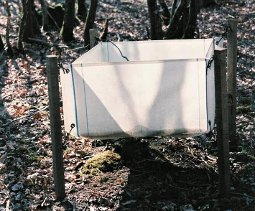
Leaf litter collection, shown here in a RENECOFOR experimental plot to measure (1) the date when all the leaves have fallen and (2) the leaf area index by direct measurement (photo N Bréda)
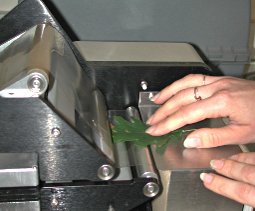
Measuring surface area of oak leaves in the laboratory (photo M Becker)
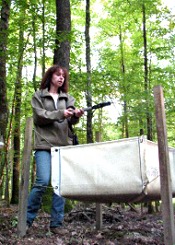
Measuring the leaf area index using a plant canopy analyzer LAI-2000 (LiCor, Nebraska, USA). Photo F. Bréda
The above-described direct method is not suitable for evergreen species, as only a fraction of needles or leaves fall during the year. Portable devices called "plant canopy analyzers" make it possible to determine on site the leaf area index for a plant canopy by using the relationship between the proportion of light intercepted by the canopy and the leaf area index.
What determines differences in Leaf Area Index between forest stands?
Species composition, stand density, silviculture, tree age, site fertility as well as recent climatic and biotic conditions are all sources of leaf area index variability. In managed forests, the first explanatory factor considered for LAI is the management of the stand itself. However, no simple relationship (generic and robust) exists between classic dendrometric variables (basal area, density, competition index) and leaf area index.
What determines temporal and spatial variability in Leaf Area Index?
Again, the greatest temporal variability in the leaf area index of a stand ralates to sylviculture techniques: thinning, clearing, manual fall and line skidding, which are all actions that temporarily contribute to variations in the the leaf area index. As such, within one forest, the LAI of oak stands can vary by a factor of three depending on the date of the last thinning.

An example of variability in leaf area index for oak when comparing plots in the same forest, measured at the same time using plant canopy analyzers.
What is the budburst date?
In BILJOU©, the date of bud break is the start of transpiration in deciduous trees, as shown using sapflow measurements. At this point, young leaves are already functional, while they may not have yet reached their maximum transpiration efficiency. From this date, leaf expansion begins and development of the leaf area index is initiated. This date corresponds to stage 15 (when the first leaves have spread over at least in 50 % of the crown) in the BBCH reference or footnote 6 of the Schuttle (1957) scale.
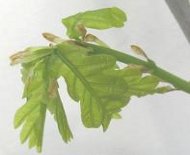
Example of young oak leaves (left) and beech leaves (right) whose transpiration is sufficient to induce xylem
sap flow and soil water absorption.
(Photo : M Zapater)
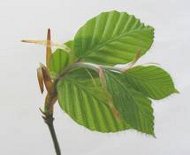
What is the date of leaf fall?
In BILJOU©, the leaf fall date (or needle fall date for larch trees) is the point when there remains only wood (trunk and branches) to intercept rainfall. Transpiration slows and finally stops prior to this date, depending on the proportion of existing green leaf area index . The date of leaf fall corresponds to stage 99 in the BBCH reference (90% of the crown leaves are no longer green or have fallen); this date corresponds roughly to ten days after stage 95. Note that it is more difficult to accurately determine this date when considering a stand's water balance.
Useful references
![]() Aussenac G, Granier A, Bréda N (1995) Effets des modifications de la structure du couvert forestier
sur le bilan hydrique, l'état hydrique des arbres et la croissance. Revue Forestière Française, XLVII,
54-62
Aussenac G, Granier A, Bréda N (1995) Effets des modifications de la structure du couvert forestier
sur le bilan hydrique, l'état hydrique des arbres et la croissance. Revue Forestière Française, XLVII,
54-62
![]() Bréda N (1999) L’indice foliaire des couverts forestiers : mesure, variabilité et rôle fonctionnel.
Revue Forestière Française, LI-2, 135-150
Bréda N (1999) L’indice foliaire des couverts forestiers : mesure, variabilité et rôle fonctionnel.
Revue Forestière Française, LI-2, 135-150
 Bréda N, Soudani K, Bergonzini J C (2002) Mesure de l’indice foliaire en forêt. GIP-ECOFOR ed.,
ISBN 2-914770-02-2
Bréda N, Soudani K, Bergonzini J C (2002) Mesure de l’indice foliaire en forêt. GIP-ECOFOR ed.,
ISBN 2-914770-02-2
![]() Lebourgeois F, Differt J, Granier A, Bréda N, Ulrich E (2002) Premières observations phénologiques
des peuplements du réseau national de suivi à long terme des écosystèmes forestiers. Revue Forestière
Française, LIV, 407-418
Lebourgeois F, Differt J, Granier A, Bréda N, Ulrich E (2002) Premières observations phénologiques
des peuplements du réseau national de suivi à long terme des écosystèmes forestiers. Revue Forestière
Française, LIV, 407-418
![]() Aussenac G (2000). Interactions between forest stands and microclimate: Ecophysiological aspects and consequences
for silviculture. Annals of Forest Sciences 57: 287-301.
Aussenac G (2000). Interactions between forest stands and microclimate: Ecophysiological aspects and consequences
for silviculture. Annals of Forest Sciences 57: 287-301.
![]() Bréda N (2008) Leaf Area Index in Ecology. Sven Erik Jorgensen & Brian D. Fath, 2008. Encyclopedia of Ecology, 1st Edition, Elsevier B.V., Oxford, 2148-2154.
Bréda N (2008) Leaf Area Index in Ecology. Sven Erik Jorgensen & Brian D. Fath, 2008. Encyclopedia of Ecology, 1st Edition, Elsevier B.V., Oxford, 2148-2154.
![]() Pitman R, Bastrup-Birk A, Bréda N, Rautio P (2010) Sampling and analysing of litterfall. Part XIII. In: Manual on methods and criteria for harmonized sampling,
assessment, monitoring and analysis of the effects of air pollution on forests. UNECE ICP Forests Programme Co-ordinating Centre, Hamburg.
ISBN: 978-3-926301-03-1, 16 p.
Pitman R, Bastrup-Birk A, Bréda N, Rautio P (2010) Sampling and analysing of litterfall. Part XIII. In: Manual on methods and criteria for harmonized sampling,
assessment, monitoring and analysis of the effects of air pollution on forests. UNECE ICP Forests Programme Co-ordinating Centre, Hamburg.
ISBN: 978-3-926301-03-1, 16 p.
![]() Bréda N J J (2003) Ground‐based measurements of leaf area index: a review of methods, instruments and current controversies.
Journal of Experimental Botany 54(392): 2403-2417.
Bréda N J J (2003) Ground‐based measurements of leaf area index: a review of methods, instruments and current controversies.
Journal of Experimental Botany 54(392): 2403-2417.
![]() Bouriaud O., Soudani K., Bréda N. (2003). Leaf area index from litter collection: impact of specific leaf area variability
within a beech stand. Canadian journal of remote sensing 29(3): 371-380.
Bouriaud O., Soudani K., Bréda N. (2003). Leaf area index from litter collection: impact of specific leaf area variability
within a beech stand. Canadian journal of remote sensing 29(3): 371-380.
![]() Soudani K, le Maire G, Dufrêne E, François C, Delpierre N, Ulrich E, Cecchini S (2008) Evaluation of the onset of green-up in temperate deciduous broadleaf forests
derived from Moderate Resolution Imaging Spectroradiometer (MODIS) data.
Remote Sens. Environ. 112: 2643-2655
Soudani K, le Maire G, Dufrêne E, François C, Delpierre N, Ulrich E, Cecchini S (2008) Evaluation of the onset of green-up in temperate deciduous broadleaf forests
derived from Moderate Resolution Imaging Spectroradiometer (MODIS) data.
Remote Sens. Environ. 112: 2643-2655
 Badeau V, Bonhomme M, Bonne F, Carré J, Cecchini S, Chuine I, Ducatillion C, Jean F, Lebourgeois F (2017). Les plantes au rythme des saisons. Biotope Editions, 336 p.
Badeau V, Bonhomme M, Bonne F, Carré J, Cecchini S, Chuine I, Ducatillion C, Jean F, Lebourgeois F (2017). Les plantes au rythme des saisons. Biotope Editions, 336 p.

